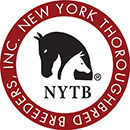 (Edited press release)
(Edited press release)
LEXINGTON, Ky. – The National Thoroughbred Racing Association (NTRA) announced Friday that Finger Lakes Gaming & Racetrack has earned reaccreditation from the NTRA Safety & Integrity Alliance. Finger Lakes has been continuously accredited by the Alliance since 2011 and, once again, the Alliance accreditation inspection team gave the Finger Lakes Thoroughbred Adoption Program (FLTAP) a “Best Practice” grading in the area of aftercare and transition of retired racehorses, noting that the FLTAP is one of the best Thoroughbred aftercare programs in the nation.
“Assuring safe retirements and second careers for horses racing at accredited racetracks has always been a critical component of the Alliance code of standards,” said Alex Waldrop, president and CEO of the NTRA. “Finger Lakes’ adoption program stands out as a racing operation that understands the important role that aftercare and transition of retired racehorses plays in the overall safety of their racing operation.”
Finger Lakes Thoroughbred Adoption Program
When Kim Delong, administration manager at Finger Lakes Gaming & Racetrack in Farmington, N.Y., describes the structure of the Finger Lakes Thoroughbred Adoption Program, she laments the fact that they have “only” two full-time staff members. And she isn’t the least bit comforted or satisfied when reminded that two is two more than most racetracks employ.
The FLTAP was ahead of its time when it was founded in 2005. In the ensuing 10 years, the rest of the industry has made great strides addressing the need for aftercare of its retired racehorses. A number of track, many of which were motivated by the Alliance accreditation process, have developed and funded their own retirement programs, while the Thoroughbred Aftercare Alliance (TAA) has established a high standard of care and is providing sustainable funding to retirement programs that comply with these standards. Still, FLTAP remains an excellent example of how tracks and horsemen can work together to safely transition retired Thoroughbreds.
“We all work together,” says Delong, the FLTAP President. “For every horse that starts at Finger Lakes the horsemen contribute $2 to our program and the association matches that with $2. The board for the adoption center is made up of horsemen and track management.”
Delong, a Farmington native who has worked on the Finger Lakes property for more than 27 years, has been involved with the FLTAP program since its inception.
“Before that one of our association vets would try to adopt out horses on her own from the backside,” Delong remembers. “We saw that there was a need for a more formal program.”
FLTAP obtained nonprofit 501(c)(3) certification in May 2006, paving the way for tax deductible donations which include not only the donated Thoroughbreds, but supplies, equipment, services and cash. Delaware North, the track’s parent company, donated two acres of land for a barn and paddocks. Ground breaking for The Purple Haze Center, named for major donor Wanda Polisenni’s Purple Haze Stables, took place in June 2007, and the center officially opened that November when the first FLTAP horses took up residence.
Since then, more than 400 Thoroughbreds have found new homes and careers through FLTAP. While many become pleasure horses, others have been retrained and found success as jumpers. Three FLTAP horses have been accepted by the Retired Racehorse Project for this year’s Thoroughbred Makeover, with $100,000 in prizes for transitioned racehorses in 10 equestrian disciplines, to be held at the Kentucky Horse Park Oct. 23-25, the weekend prior to the Breeders’ Cup World Championships at Keeneland.
More on Finger Lakes Reaccreditation
In the final accreditation report, Finger Lakes was commended not only for a best practice in aftercare and transition of retired racehorses but also for exceeding the Alliance code of standards in the following areas: (i) reporting of injuries and fatalities; (ii) pre-race veterinary examination protocols; (iii) post-race veterinary examination protocols; (iv) veterinarians’ list protocols; (v) safety vests and helmets; (vi) racing surfaces testing and data collection protocols; (vii) jockeys’ insurance; (viii) race cancellation policy; and (ix) wagering pool due diligence.
“Finger Lakes has displayed diligence and a keen desire to do things right,” said Steve Koch, executive director of the Safety & Integrity Alliance. “Finger Lakes management clearly has maximized their available track resources to achieve success in the areas of safety and integrity.”
The reaccreditation of Finger Lakes was the culmination of a lengthy process that began with the track’s completion of a 48-page written application and continued as Finger Lakes hosted several meetings with Alliance officials. An on-site review included inspections of all facets of the racing facility. Interviews were also conducted with track executives, racetrack personnel, jockeys, owners, trainers, stewards and fans. The inspection team was comprised of Dr. Ron Jensen, DVM, former equine medical director for the California Horse Racing Board; Mike Kilpack, security and integrity consultant and past chairman of the Organization of Racetrack Investigators; Richard Lewis, former trainer and Northern California racing executive; and Mike Ziegler, former executive director of the NTRA Safety & Integrity Alliance.









